What to Do About Thistle Seed Mess From Feeding Finches
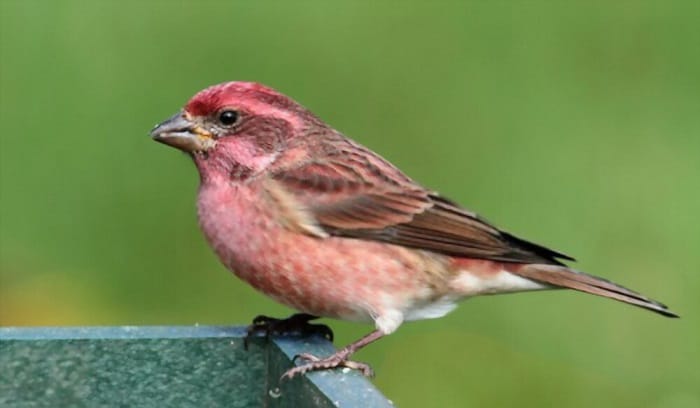
The survival of thousands of bird species relies on their access to various food sources. And one of the staple foods for feathered creatures is nyjer seeds. But what birds eat thistle seed? The list includes juncos, chickadees, finches, buntings, quails, sparrows, doves, redpolls, thrushes, and siskins.
By knowing what birds love thistles, you can attract birds using nyjer seeds. This makes your yard more appealing and beautiful with feathered visitors.
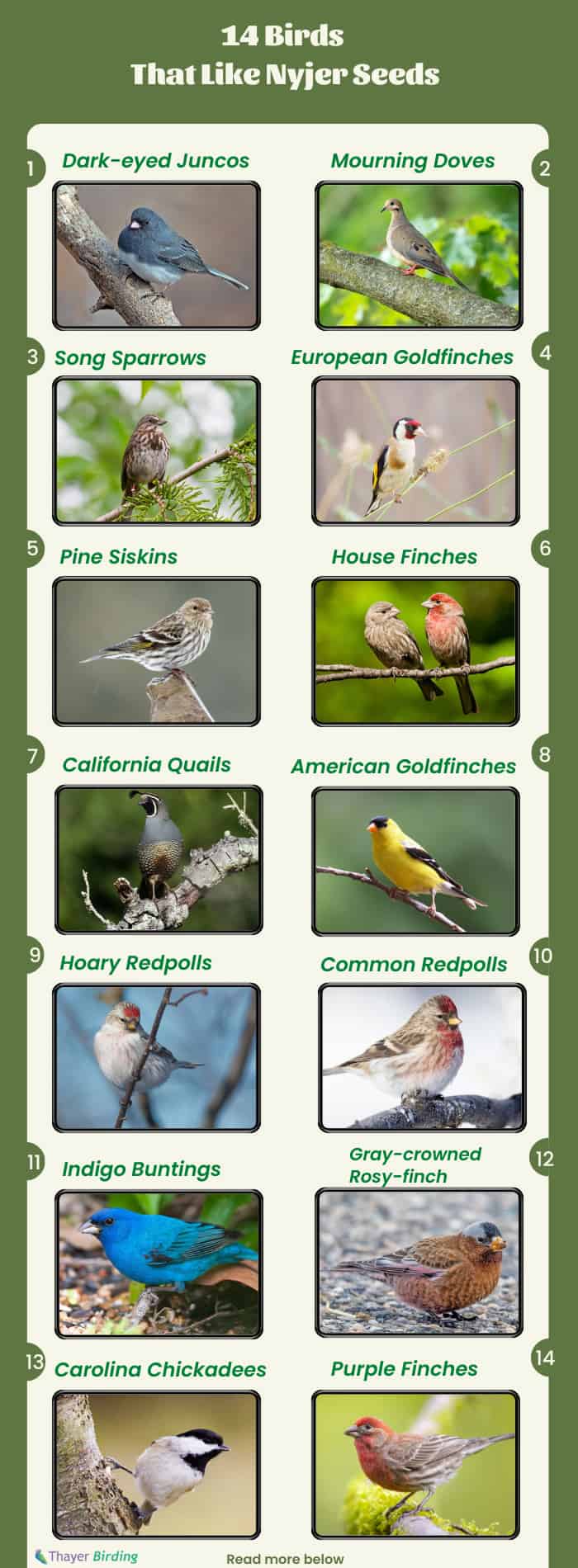
Table of Contents
- What Is a Thistle Seed?
- Birds Species That Like Nyjer Seeds
- 1. Dark-eyed Juncos
- 2. Mourning Doves
- 3. Song Sparrows
- 4. European Goldfinches
- 5. Pine Siskins
- 6. House Finches
- 7. California Quails
- 8. American Goldfinches
- 9. Hoary Redpolls
- 10. Common Redpolls
- 11. Indigo Buntings
- 12. Gray-crowned Rosy-finch
- 13. Carolina Chickadees
- 14. Purple Finches
- Best Practices on Using Thistle Seeds
- 1. Bird Feeder For Thistle Seeds
- 2. Bird Feeder Protection
- 3. Attracting Birds With Thistle Seeds
- Conclusion
What Is a Thistle Seed?
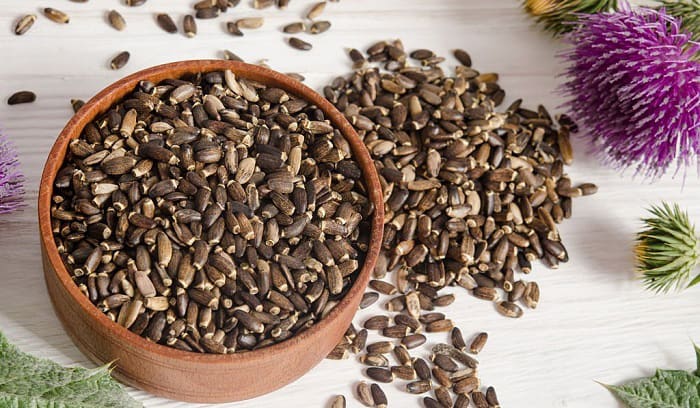
Thistle feeding birds love this kind of seed thanks to their high-calorie content that provides energy. These tiny, black, and flat thistle seeds are also called nyjer seeds or niger seeds. They are extracted from the American yellow daisies, then sterilized and packaged.
Birds eat nyjer seed from feeders, and this expensive seed can be mixed with less pricey seeds to stay within your budget.
Birds Species That Like Nyjer Seeds
Seeds are common favorites of birds, but not all avians love thistle seeds. The ones that do are referred to as clinging birds. These are small birds that cling to feeders, sometimes even upside-down just to access the tiny nyjer seeds.
1. Dark-eyed Juncos
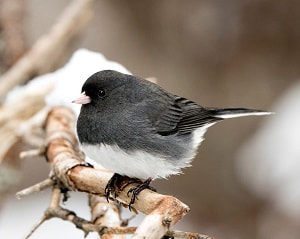
If you're wondering do juncos eat thistle seed, yes they do. Dark-eyed juncos have diverse coloring (gray, brown, black, white) depending on their location. They are ground dwellers and thrive in open and slightly concealed areas.
2. Mourning Doves
Mourning doves are also called American mourning doves, rain doves, and turtle doves. They have a length of 22-36cm, and body weight of 120g. These white birds are often seen in woodlands, nature parks, and yards in North America. And to lure them to your feeder, offer them thistle seeds.
3. Song Sparrows
The brown song sparrows are frequent feeder visitors, and their beautiful song brings happiness to residences. They weigh 12-53g, with a length of 4.7-6.7 inches, and wingspan of 7.1-9.4". North American song sparrows are non-migratory. They love insects, plants, grains, berries, sunflower seeds, and nyjer seeds.
4. European Goldfinches
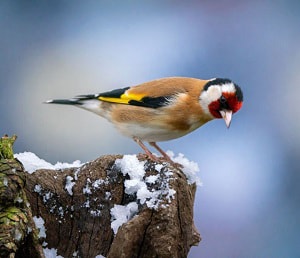
The small songbirds called European goldfinches are also referred to simply as goldfinches. Their plumage colors are black, white, brown, red, and yellow. Adult goldfinches are 12-13cm long, with a weight of 14-19g.
5. Pine Siskins
Pine siskins have a brown coloring with splashes of yellow on their plumage. These small finches have short, conical bills that allow them to crack niger seeds well. And they, of course, love pine trees.
6. House Finches
Learning about the thistle finch food is highly beneficial in attracting house finches to your yard. These birds are 5.1-5.5" long, weigh 16-27g, and have a wingspan of 7.9-9.8". Males have scarlet chests and heads and brown bodies, and their coloring changes depending on the food they consume.
These noisy avians feed on thistle seeds, buds, and fruits.
7. California Quails
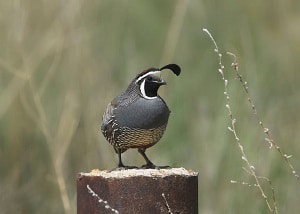
The ground-dwelling quails are also known as valley quails or California valley quails. Adults have an average body mass of 160g. These quails are highly sociable and families usually stay together.
8. American Goldfinches
American Goldfinches have agile feet to grab seeds for feeding, and the shape of their beaks allows easy seed acquisition. They won't shy away from feeders if humans stock them with the right food. And they like eating nyjer seeds, sunflower seeds, and aster plants.
9. Hoary Redpolls
The thistle seeds for birds are perfect meals for the small hoary redpolls. These birds have a noticeable scarlet patch on their temples, which complements their white color. The pinkish breasts of the males are non-existent in females. This bird breed is 4.7-5.5" long, weighs 11-20g, and has a wingspan of 8.5-9.25".
10. Common Redpolls
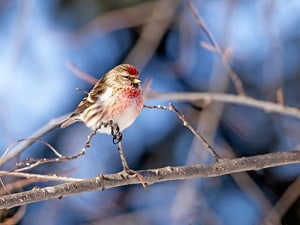
Like the hoary redpoll, the common redpoll has crimson foreheads. The latter has a length of 4.7-5.5", weight of 11-20g, and wingspan of 7.5-8.7". They are mostly found in northern America for the winter. These birds survive the frost by eating good sources of energy, like the thistle seeds.
11. Indigo Buntings
Indigo buntings are beautiful migrant birds that love thistle seeds. They typically migrate at nighttime, prefer to roost and nest in open forests, agricultural areas, and brushes. Adults are 12-15cm long, coupled with a weight of 14g. Males take full advantage of their vivid blue color to find mates.
12. Gray-crowned Rosy-finch
Gray-crowned rosy-finches are medium-sized. They have black temples and throats, hazel bodies, gray crests, and pinkish bellies. These birds can gather in big groups when they're not breeding (up to 1000 birds) and can be within 1 to 2 meters of humans without being scared. They feed on insects, niger seeds, and weeds.
13. Carolina Chickadees
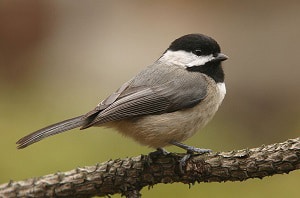
Carolina chickadees are small creatures that are distinctive with their black, gray, and white colors. They're 3.9-4.7" long, weigh 8-12g, and have a wingspan of 5.9-7.9". These feeder-visitor birds love thistle seeds, especially when mixed with suet and black sunflower oil seeds.
14. Purple Finches
Purple finches have a color fusion of red, white, and brown. They have a length of 4.7-6.3", weight of 18-32g, and a wingspan of 8.7-10.2". This bird species prefers evergreen woodlands, where they search for nyjer seeds, berries, nectar, and buds.
And in the breeding season, they nest on top of trees. They are birds that eat thistle, so fill your feeder with this food.
Best Practices on Using Thistle Seeds
Thistle seeds are expertly sterilized prior to packaging in order to stop them from growing. However, take note that if nyjer seeds fall from the feeder, they can sprout from the ground.
So it's best to always clean up your garden daily, or choose the right feeder that will keep the seeds from falling to the earth.
1. Bird Feeder For Thistle Seeds
Opt for a bird feeder that can accommodate small seeds, since nyjer seed for birds are quite tiny. There are a couple of feeders to choose from, and the best kind are called finch feeders. These feeding tools can be metal feeders with small openings, or transparent tube designs.
However, keep in mind that thistle feeders are not appealing to hummingbirds, bluebirds, orioles, wrens, and tanagers. But you can always buy other kinds of feeders if you want to attract these birds to your yard.
With the use of nyjer feeders, only fill them halfway. You can't allow the seeds to spoil. Anyway, you can always refill when the feeder is empty.
2. Bird Feeder Protection
Niger seeds can also attract other animals such as rats. That's why it's imperative to safeguard the food, so only your target birds can eat it. Use a squirrel-proof bird feeder, or you can install a dome cover to deter squirrels and large birds from taking advantage of the feeder.
3. Attracting Birds With Thistle Seeds
Always use fresh thistle seeds for your bird feeder. Birds tend to stay clear of spoiled food, so throw away old nyjer seeds and replace them with fresh ones. And though it's not recommended to spread the seeds on the ground, you can do so if birds aren't coming to your yard. Just make sure to clean them up at the end of the day.
Also, make your feeder visible and attractive by opting for red, orange, yellow, and blue colors. These shades appeal to birds, so they're likely to feed on your food offering, especially in the winter season. More importantly, buy a high quality thistle seed brand to make the birds come back.
Conclusion
Knowing what birds eat thistle seed allows you to anticipate the avian species that will frequent your yard. Nyjer seeds are a good source of energy, and especially beneficial for birds in the freezing months.
We hope this article provided you with the right information about thistle seeds and the birds that love them. Kindly share this post to people you know. And you're always welcome to share your thoughts.
Source: https://www.thayerbirding.com/what-birds-eat-thistle-seed/
0 Response to "What to Do About Thistle Seed Mess From Feeding Finches"
ارسال یک نظر